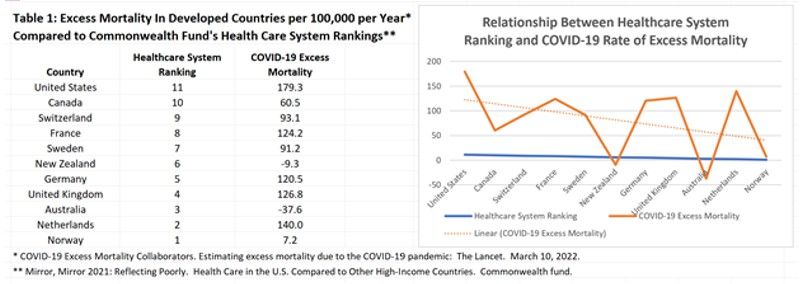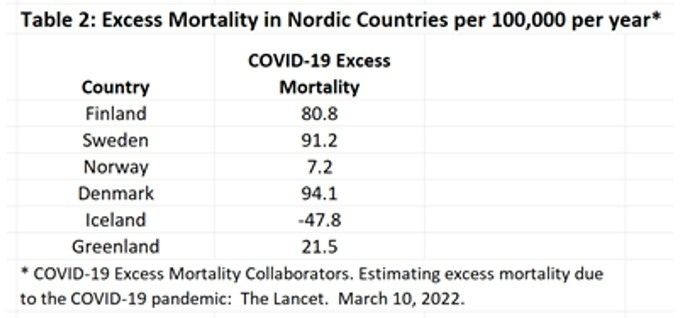How Does the US Response to COVID-19 Compare With the Rest of the World?
Other nations, such as Sweden and Australia, outperformed the US metrics.
Kevin Kavanaugh, MD

One of the most discussed topics has been how the United States’ COVID-19 response compares with the rest of the world. Being one of the richest and most developed nations in the world, the United States should have had one of the best responses. The often-quoted statistic is that we have more SARS-CoV-2 cases than any other nation in the world, currently over 81.4 million. However, when one adjusts for population, the United States drops to the 49th worst nation, which is still not very good.
But then, the United States also has an organized reporting system, and its poor ranking may be because of robust reporting and thus, recording of more cases. In some countries, a positive COVID-19 test is required for a diagnosis, and in many nations, those are in very short supply.
Another metric that can be used to measure a country’s performance is deaths. One may state that patients in poor countries may not have access to their health care system and be more likely to die. However, in those countries, deaths may not always be reported; and our health care system is not, by many measures, the best in the world. We do not have universal health care and have reduced access for many of our high-risk citizens. According to the Commonwealth Fund, of 11 high-income nations, the United States is dead last in access to care, equity, health care outcomes, and overall ranking. Unfortunately, in all of the categories but care processes, the United States vastly underperforms the next closest high-income country.
Recently, an important paper was published in The Lancet regarding excess mortality during the COVID-19 pandemic. Excess mortality is determined by the number of deaths that are above a country’s average number of expected deaths as measured over previous years. Many lessons can be learned from this data. Although mortality rate is a different metric than cases, the 2 are closely related and comparable in countries with equivalent health care systems.
Table 1: Courtesy of Kevin Kavanaugh, MD.

Table 1 compares the Commonwealth Fund’s rankings for the 11 high-income countries and the rates of excess mortality per 100,000 population/per year. The United States has the highest rate of COVID-19 deaths per capita.
The assertion that the United States has performed the worst in the world is not true. Although several examples of third-world nations outperforming the United States exist, there are also many examples where this was not the case. Central and Latin America has a reported COVID-19 mortality rate of 124.1 per 100,000 per year. On face value, this rate is better than the United States’ mortality rate of 130.6. However, the excess mortality rate in Central and Latin America was 274.4 compared with the United States’ rate of 179.3. Thus, the observed low COVID-19 rate in Central and Latin America was probably due to underreporting. In contrast, Southern Latin America (Argentina, Chile, and Uruguay) outperformed the United States with a COVID-19 mortality rate of 129.0 and an excess mortality rate of 150.2. The closer approximation of excess mortality to COVID-19 mortality in Southern Latin America indicates that they possibly had a more robust and accurate reporting system.
Further, Sweden has also been a hot topic, since the perception in the United States is that they have done less and outperformed the United States. It is true that they did not implement all the strategies that were implemented in the United States, but they implemented many approaches, such as travel restrictions, limitations on the size of gatherings, social distancing, school closures, and work from home programs. The key difference from the United States is that Sweden had a much larger portion of its population adhere to these measures. In addition, Sweden has a higher ranked health care system (see Table 1) and a lower poverty level than the United States. Sweden’s population is also less likely to live in crowded tenement conditions and has greater access to their health care system.
Table 2. Courtesy of Kevin Kavanaugh, MD.

Although Sweden’s excess mortality is better than the United States’, compared with other Nordic Countries, many of which implemented more stringent measures, Sweden did not fare as well (see Table 2). Sweden has one of the highest excess mortality rates, only behind Denmark. Many of the Southeast Asian countries have very low excess death data, which is the result of their near zero COVID-19 policy. Of interest, as shown in Table 1, Australia and New Zealand have a negative excess death rate (-37.6 and -9.3 respectively). In addition, South Korea has an excess death rate of 4.4, Singapore -15.8, and Taiwan of -5.9. In other words, most of these countries’ populations lived longer than expected, possibly as a result of maximizing public health strategies. The Lancet study’s data acquisition period ended on Dec. 31, 2021, and many Southeast Asian countries are currently experiencing a very large BA.2 surge. BA.2 is highly infectious and is overcoming many public health strategies. Thus, these countries may well experience a very large surge, but if BA.2’s lethality is similar to Omicron’s, they may still have mitigated the large number of deaths that have occurred in the rest of the world.
The ratio of excess COVID-19 mortality to reported COVID-19 mortality in the United States is 1.37. This means that the increase in deaths that occurred in the United States was greater than the number of COVID-19 cases reported. In the United Kingdom, this ratio was 0.97. A decrease in some categories of deaths can occur during a pandemic, for example, from other respiratory illnesses. Thus, the United Kingdom’s reporting, on average, appears to be highly accurate. In my home state of Kentucky, this ratio was 1.68.
Overall, the data in The Lancet study regarding excess mortality does not support the contention that the United States has had the worst response in the world. This appears to be a statistical argument that does not consider the underreporting in many countries. However, the data does show that the United States is below average in the world and among the worst in the developed and high-income nations. We need to learn the lessons of this pandemic, reform our health care system, and improve messaging along with public acceptance of mitigation strategies. The United States can and must do better.
The Value of Certification in Infection Prevention and Control: Why Is it important?
May 14th 2024Certification in infection prevention and control is essential for career growth, higher salaries, and improved patient outcomes. Learn why certification matters from Shazia Irum, MSC, MBA, RN, CIC, CPHQ, CBIC Ambassador in Saudi Arabia.